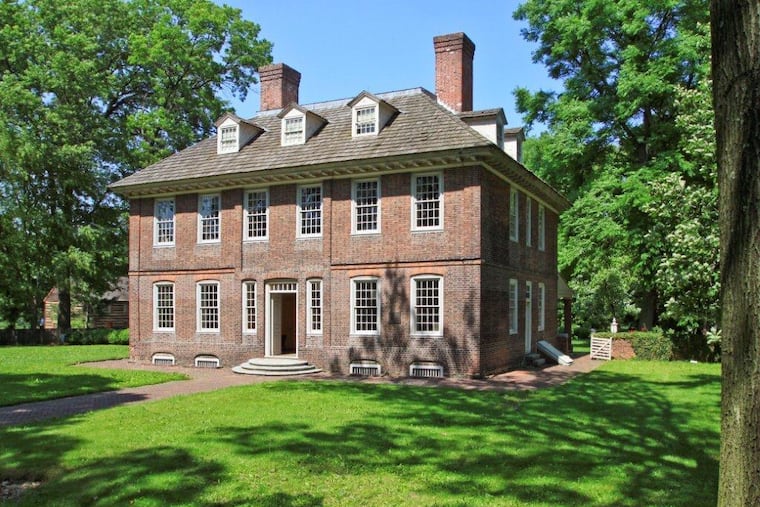Historic Stenton to honor enslaved housekeeper who saved the house from burning by the Brits
Little is known of Dinah, who lived in the 18th century, but her name is, in a sense, legend.

It is not known exactly when Dinah was born or when she died.
Actually, no one is exactly sure of anything about Dinah other than that she was owned by Hannah Emlen Logan, wife of William Logan, proprietor of Stenton, the great historic house at 4601 N. 18th St. in Logan, hard by Germantown.
Slavery is an obdurate fact, and the 18th-century Quakers of Philadelphia were increasingly repulsed by it, leading the Logans, one of the city’s great founding Quaker families, to free Dinah in 1776.
She kept working for the family, and legend has it (backed by whiffs from the documentary record) that Dinah’s quick wits saved Stenton from being burned to the ground by marauding British soldiers after the Battle of Germantown.
Stenton, built in 1730 by William Logan’s father, James Logan, William Penn’s secretary, has embarked on a project to attract and engage its neighbors and to memorialize Dinah in an area that offers little public acknowledgement of the African American presence in the neighborhood’s history.
At 2 p.m. Monday, Dec. 17 and 5:30 p.m. Tuesday, Dec. 18, Stenton will welcome community members to participate in a public planning process.
“We’re facilitating a community dialogue,” said Dennis Pickeral, Stenton’s executive director. “We want to know what people want to see, where it should be, what it might look like. This will all inform how we portray Dinah.”
The project has its roots in the fact that Stenton recently took over stewardship of a 1939 cast-bronze memorial to James Logan that once stood in front of the Library Company of Philadelphia and moved it to the Stenton grounds.
There was a hitch, Pickeral noted: James Logan was a slave owner, and though the monument now has a new life at Stenton, it comes at a fraught time when monuments tied to slavery and racism are sparking strong reactions around the country.
Enter the focus on Dinah. How should Stenton address its past and meet its present and future?
“We have a 1912 memorial to Dinah,” Pickeral said, and it became obvious that Stenton ought “to elevate her story in a way that’s appropriate in a 21st-century way…. And that we work with our neighbors to achieve that.”
The memorial, a bronze plaque, characterizes Dinah as Stenton’s “faithful colored caretaker” — not exactly the stuff of the 21st century.
But how do you memorialize someone who has left so little of a documentary trail?
As best as Pickeral and Stenton curator Laura Keim can figure, Dinah was born in the late 1720s; the last reference to her in the Logan family papers is from 1803. She lived, then, at a time when there was growing Quaker agitation and sanctions against the institution of slavery.
That led to some ironies. Dinah’s husband, owned by another family, was purchased by the Logans at Dinah’s request in 1757. He had rejected manumission because of poor health and "chose to live in his present [enslaved] Situation with his Wife,” according to Quaker records.
The Logans then became the subjects of an investigation by the Quaker monthly meeting, which finally decided the purchase of Dinah’s husband, though not exactly approved, was in some sense humanitarian.
It is not known when Dinah’s husband died, but Dinah was freed by the family at her request in April 1776. She stayed on at Stenton as housekeeper, and family papers record in August 1777 that “Negro Dinah was paid her wage in full — [12 pounds].”
In November 1777, the story goes, Dinah was alone at Stenton when two British soldiers banged on the door and informed her the mansion would be burned. They then headed to the barn to gather straw for the blaze.
At that point, a small detachment of British troops showed up and asked Dinah whether any deserters had passed her way. Her “quick thought,” as virtually every story concludes, led her to send them to the barn.
The British detachment gathered up the would-be British arsonists and led them away.
Stenton was saved.
There are numerous versions of this story that have made their way into popular accounts with greater and greater elaboration, according to Keim and Pickeral. Virtually none can be corroborated.
But one thing is clear: Dinah was a key figure in the life of the Logans, a key figure in the life of Stenton, and she deserves to be commemorated.
Her story is known in the Germantown, Nicetown, and Logan neighborhoods, and the hope is that her name will induce lively community participation in the planning of the public memorial.
Said Pickeral: “The community sees her as very uplifting.”